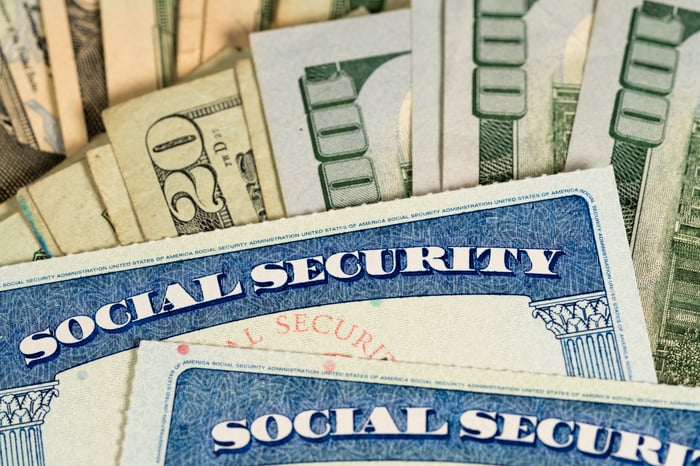For the past three months, the coronavirus disease 2019 (COVID-19) pandemic has completely upended what seemed to be an unstoppable U.S. economy. Mitigation measures designed to slow the transmission of the coronavirus have led to more than 36 million Americans filing for initial unemployment benefits in an eight-week stretch, and they may well throw the U.S. into a recession for the first time in more than a decade.
Knowing full well the ramifications tied to slowing the spread of COVID-19, Congress passed and President Trump signed the Coronavirus Aid, Relief, and Economic Security (CARES) Act into law on March 27. At $2.2 trillion, the CARES Act provided sweeping relief to distressed industries, small businesses, the unemployment benefits program, and hospitals.

Image source: Getty Images.
The first round of stimulus money wasn't nearly enough for most Americans
But what the CARES Act will most be remembered for is the approximately $300 billion set aside for direct stimulus payments to more than 150 million Americans and seniors. According to a May 8 update from the Internal Revenue Service, close to 130 million taxpayers have already received, or been assigned, their Economic Impact Payment (as these stimulus payouts are officially known).
Stimulus recipients can expect to receive a maximum of $1,200 per individual and $2,400 for a couple filing jointly. To receive this maximum, a single, married, or head-of-household filer would need to have a respective adjusted gross income below $75,000, $150,000, and $112,500 in their most recent tax filing. Additionally, qualifying children under the age of 17 can add $500 per child to what a parent or household can receive.
There's no question that this money was very much needed, with the latest unemployment report delivering grim news: the highest unemployment level since the Great Depression (14.7%). Yet, the money provided to most workers and their families disappeared in the blink of an eye. A Money/Morning Consult survey of 2,200 people in April found that 74% expect their stimulus money to be used up in four weeks or less. With the U.S. economy nowhere near ready to bounce back, it's looking very likely that additional stimulus will be needed for working Americans and their families.
The big question is, what form should a new stimulus take?

Image source: Getty Images.
A $5,000 stimulus check...that's really a loan
In recent weeks, I highlighted four proposals that have been making their rounds on Capitol Hill. We've seen calls for a second round of stimulus checks, efforts to rebate payroll taxes for employers, and a bill calling for mortgage and rental forgiveness for up to a year. But there's a new suggestion winding its way through Washington, D.C., and it's taken a markedly different approach to providing stimulus to workers and their families.
A recently published opinion piece in The Hill from Andrew Biggs of the American Enterprise Institute and Joshua Rauh of the Hoover Institution calls for stimulus checks of, say, $5,000 to be paid to workers who voluntarily want to receive them. These $5,000 checks would be treated as loans from the Social Security trust fund, with an interest rate of between 1% and 1.5%, as outlined in the article.
The catch is that taking this upfront loan from Social Security would mean having to delay the receipt of your initial Social Security payout, because your initial payments would go toward paying back this loan. Once your loan is paid off, your monthly benefits would be restored in full. Currently, retired workers aren't able to begin taking their Social Security benefits prior to age 62.
According to Biggs and Rauh, workers would have the choice to refuse this $5,000 stimulus check, which would leave their payout options unchanged from where they are now.
Biggs and Rauh view this as a no-brainer solution, as it would allow the public to borrow at rates that are well below what they could receive from the private market (e.g., from banks), and it wouldn't further widen an already ballooning federal deficit by inefficiently distributing stimulus money for a second time.

Using Social Security's trust fund as a lending source would be a big gamble. Image source: Getty Images.
This $5,000 stimulus check looks like a wolf in sheep's clothing
On the surface, the idea of providing workers with access to their future benefits sounds tempting. Unfortunately, there are far too many things that could go wrong with this approach -- it really looks like nothing more than a plan to reduce future Social Security payouts.
One of the biggest issues is that if too many people opt to receive an upfront stimulus at once (i.e., a loan from the Social Security trust), it'll result in an even quicker depletion of Social Security's $2.9 trillion in asset reserves. Remember, the latest Trustees report forecast only 15 years before these asset reserves are completely exhausted. Although Biggs and Rauh suggest that the actuarial balance for the program would be unchanged, this is an unlikely scenario.
Another concern is that Biggs and Rauh may not have accurately accounted for the number of stimulus recipients who won't repay their loans. They note that a 0.5% interest rate on outstanding stimulus loans should offset folks who die before reaching the eligible age to claim benefits, and thus do not repay their loans. But they fail to account for folks who go on long-term disability or who don't earn the 40 work credits needed to receive a retirement benefit. Chances are that the Social Security program won't recoup all of its loans.
A $5,000 stimulus loan would also disproportionately hurt lower-income workers, since it'll take longer for them to repay their loans. Biggs and Rauh suggest it'll take three months for the typical worker to repay their loan. Today, the average retired worker rakes in a little over $1,500 a month. But low-income workers may only take home around $900 monthly. It could take significantly longer for low-income individuals to repay this loan, crippling their income stream early in retirement.
Lastly, providing an upfront $5,000 check might adversely affect worker productivity. If workers suddenly have the choice to receive $5,000, they might decide to stay out of work even longer. That's a big problem for Social Security given that the payroll tax on wages and salary accounted for 89% of the $1.06 trillion the program collected in 2019. If worker productivity falls, Social Security's earning power goes down the tubes.
A stimulus check loan from the Social Security trust fund is a novel idea. Too bad it's an awful idea.
"really" - Google News
May 22, 2020 at 05:15PM
https://ift.tt/2Xj8s13
The $5,000 Stimulus Check Proposal Is Really a Social Security Cut in Disguise - The Motley Fool
"really" - Google News
https://ift.tt/3b3YJ3H
https://ift.tt/35qAk7d
Bagikan Berita Ini














0 Response to "The $5,000 Stimulus Check Proposal Is Really a Social Security Cut in Disguise - The Motley Fool"
Post a Comment